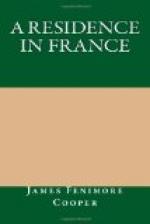The next morning we were off betimes to avoid the heat, and reached Ludwigsberg to breakfast. Here the scene began to change. Troops were at drill in a meadow, as we approached the town, and the postilion pointed out to us a portly officer at the Duke of Wurtemberg, a cadet of the royal family, who was present with his staff. Drilling troops, from time immemorial, has been a royal occupation in Germany. It is, like a Manhattanese talking of dollars, a source of endless enjoyment.
Ludwigsberg is the Windsor, the St. Denis, of the Princes of Wurtemberg. There an extensive palace, the place of sepulture, and a town of five or six thousand inhabitants. We went through the former, which is large and imposing, with fine courts and some pretty views, but it is low and Teutonic—in plain English, squat—like some of the old statues in armour that one sees in the squares of the German towns. There is a gallery and a few good pictures, particularly a Rembrandt or two. One of the latter is in the same style as the “Tribute-money” that I possess, and greatly encourages me as to the authenticity of that picture. The late Queen of Wurtemberg was the Princess Royal of England, and she inhabited this palace. Being mistaken for English, we were shown her apartments, in which she died lately, and which were exactly in the condition in which she left them. She must have had strong family attachments, for her rooms were covered with portraits of her relatives. The King of England was omnipresent; and as for her own husband, of whom, by the way, one picture would have been quite sufficient for any reasonable woman, there were no less than six portraits of him in a single room!
As one goes north, the style of ornamenting rooms is less graceful, and the German and English palaces all have the same formal and antiquated air. Ludwigsberg does not change the rule, though there was an unusual appearance of comfort in the apartments of the late Queen, which had evidently been Anglicised.




